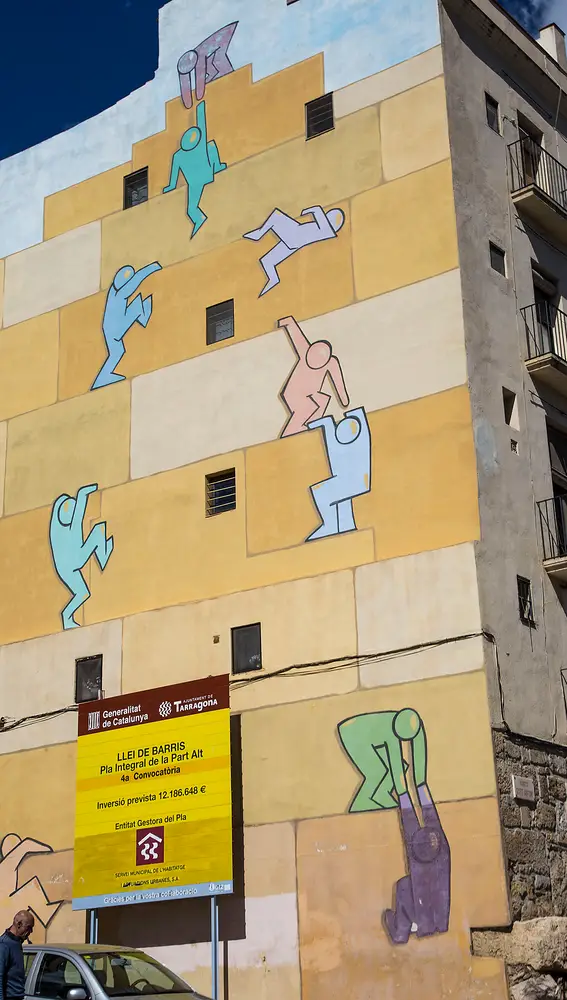Talking Walls in Tarragona
- Hugo

- Oct 6, 2021
- 3 min read
Updated: Nov 11, 2022
With the project “Murs que parlen” (talking walls), Tarragona is transforming its streets into a large art gallery. Not unexpected, because Spain is already “world champion” in street art. Finally, in this blog the most beautiful Spanish and Catalan poems on Dutch walls.

If you walk through Tarragona city, you can't miss the beautiful wall art. Since 2008, the municipality has been supporting this street art through the 'talking walls' project, which promotes young artists access to public spaces. Since then, the initiatives have only expanded. For example, permission to paint in public spaces is now granted within 48 hours.

And the result is impressive. Various artists have since painted many walls, windows and facades of abandoned buildings and demolished houses. There are over 100 such works of art throughout the city. Various agencies also offer guided street art tours.
The most famous wall art in the old town is undoubtedly the one in Plaça dels Sedassos, painted by Carles Arola in 1995 (see photo at the top of this blog). He has used the trompe-l'oeil technique, which creates an optical illusion that the figures and objects are real. According to many guides a must-see.

A much-photographed wall is also the one on Paseo de Sant Antoni, with its climbing figures. And in the harbor district of the Serrallo you can see a beautiful art collection from 15 artists. This collective street art exhibition is known as the 'Color Zone' (also because of the colorfully painted houses). Another phenomenon in Tarragona is the painted poles of 'Pilon Street'. Every year in July they are painted over during a wonderful party with live music (see our page with parties in Tarragona). Below is a short impression of street-art in the city.
Spain “world champion” street art
But in Spain this initiative in Tarragona is not isolated. Recently, the largest urban art community in the world (Street Art Cities) named a work of art in the Spanish city of Lugo (Galicia) as the best mural art in the world. It concerns an image of Julius Caesar, painted by Diego As on a wall of 20 by 20 meters on the Ronda da Muralla in Lugo (see photo below). The artist from Lugo had previously been voted the best graffiti artist in the world.

But it goes further than that. An entire Spanish village near Valencia (Fanzara) has been completely transformed into an open-air gallery. Locals and artists have painted the white walls here with colorful artwork. It started with a street art festival in which 21 artists took part. But three years later, this MIAU festival (Unfinished Museum of Urban Art) has grown into a renowned event for which more than 200 artists have now registered.
Spanish and Catalan wall poems in the Netherlands
The Netherlands also has its wall art. Within the project 'Poems on walls', more than 100 beautiful international poems have appeared on the walls in the city of Leiden since 1992. Also Spanish and Catalan poems.
For example the poem De Profundis by the famous Spanish poet Federico García Lorca, who wrote this in 1921 as part of a total of eight poems. It is inspired by the Petenera, a traditional flamenco dance. The poem can be found at Langebrug 56 (at the intersection with Zonneveldstraat) in Leiden.

DE PROFUNDIS (by Federico García Lorca)
Those hundred lovers
are asleep forever
beneath the dry earth.
Andalusia has
long, red-colored roads.
Córdoba, green olive trees
for placing a hundred crosses
to remember them.
Those hundred lovers
are asleep forever.
At least as impressive are the poems of the Catalan poet Salvador Espriu, who was nominated for the Nobel Prize at the time. His poem Pluja (rain) can be found at the Rijn en Schiekade 125 (on the corner of Telderskade).

PLUJA (by Salvador Espriu)
It comes from nowhere. Leave?
There's no magic word that can break
this monotone, the staring, the sonorous silence
like that of arrows. The spring, and the abundance
of years and of light, lie lost
on the road behead. The expectations died away
completely in the end. Once again everything is utterly
in a vacuum: the slow rain
is going nowhere.
Salvador was very devoted to the Catalan language (a dangerous occupation at that time under Franco) but always focused on dialogue. Personally, I think his poem “La pell de brau” (“The skin of the bull”) from 1960 is his most beautiful.
In Tarragona a street is named after him, only a 5 minute walk from our house: Carrer Salvador Espriu. And so we're back again in the city from where we started this blog: a wonderful round of street art. And always close by, in both Spain and the Netherlands!
.





















Comments